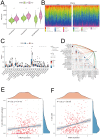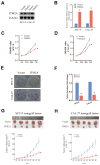Integrating machine learning, bioinformatics and experimental verification to identify a novel prognostic marker associated with tumor immune microenvironment in head and neck squamous carcinoma
- PMID: 39720726
- PMCID: PMC11666523
- DOI: 10.3389/fimmu.2024.1501486
Integrating machine learning, bioinformatics and experimental verification to identify a novel prognostic marker associated with tumor immune microenvironment in head and neck squamous carcinoma
Abstract
Head and neck squamous carcinoma (HNSC), characterized by a high degree of malignancy, develops in close association with the tumor immune microenvironment (TIME). Therefore, identifying effective targets related to HNSC and TIME is of paramount importance. Here, we employed the ESTIMATE algorithm to compute immune and stromal cell scores for HNSC samples from the TCGA database and identified differentially expressed genes (DEGs) based on these scores. Subsequently, we utilized four machine learning algorithms to identify four key genes: ITM2A, FOXP3, WIPF1, and RSPO1 from DEGs. Through a comprehensive pan-cancer analysis, our study identified aberrant expression of ITM2A across various tumor types, with a significant association with the TIME. Specifically, ITM2A expression was markedly reduced and correlated with poor prognosis in HNSC. Functional enrichment analysis revealed that ITM2A is implicated in multiple immune-related pathways, including immune-infiltrating cells, immune checkpoints, and immunotherapeutic responses. ITM2A expression was observed in various immune cell populations through single-cell analysis. Furthermore, we showed that ITM2A overexpression inhibited the growth of HNSC cells. Our results suggest that ITM2A may be a novel prognostic marker associated with TIME.
Keywords: HNSC; ITM2A; immune microenvironment; machine learning; prognostic.
Copyright © 2024 Zeng, Yang, Zhang, Li, Wang, Ma, Liao, Wang, Zeng and Zhang.
Conflict of interest statement
The authors declare that the research was conducted in the absence of any commercial or financial relationships that could be construed as a potential conflict of interest.
Figures









Similar articles
-
Integrative bioinformatics and machine learning identify key crosstalk genes and immune interactions in head and neck cancer and Hodgkin lymphoma.Sci Rep. 2025 May 6;15(1):15745. doi: 10.1038/s41598-025-99017-5. Sci Rep. 2025. PMID: 40328901 Free PMC article.
-
ADORA2B promotes proliferation and migration in head and neck squamous cell carcinoma and is associated with immune infiltration.BMC Cancer. 2025 Apr 12;25(1):673. doi: 10.1186/s12885-025-14102-2. BMC Cancer. 2025. PMID: 40221657 Free PMC article.
-
Machine learning-driven identification of exosome- related biomarkers in head and neck squamous cell carcinoma.Front Immunol. 2025 May 22;16:1590331. doi: 10.3389/fimmu.2025.1590331. eCollection 2025. Front Immunol. 2025. PMID: 40475773 Free PMC article.
-
Comprehensive characterization of the alternative splicing landscape in head and neck squamous cell carcinoma reveals novel events associated with tumorigenesis and the immune microenvironment.Theranostics. 2019 Oct 14;9(25):7648-7665. doi: 10.7150/thno.36585. eCollection 2019. Theranostics. 2019. PMID: 31695792 Free PMC article.
-
Heterogeneity of the tumor immune cell microenvironment revealed by single-cell sequencing in head and neck cancer.Crit Rev Oncol Hematol. 2025 May;209:104677. doi: 10.1016/j.critrevonc.2025.104677. Epub 2025 Feb 27. Crit Rev Oncol Hematol. 2025. PMID: 40023465 Review.
References
-
- Vos JL, Elbers J, Krijgsman O, Traets J, Qiao X, van der Leun AM, et al. . Neoadjuvant immunotherapy with nivolumab and ipilimumab induces major pathological responses in patients with head and neck squamous cell carcinoma. Nat Commun. (2021) 12:7348. doi: 10.1038/s41467-021-26472-9 - DOI - PMC - PubMed
MeSH terms
Substances
LinkOut - more resources
Full Text Sources
Medical

